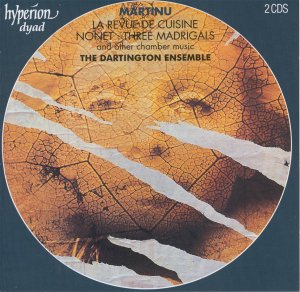Five of the eight works
in this handsomely turned-out set come from the period after Martinů's
flight from Paris. La Revue, the Sonatina and the
Four Madrigals were written during his Parisian years.
The Madrigal connection for the four works on the first
CD can be traced back not to any encounter with Monteverdi or with of
the other early Italian madrigalists but to a perhaps unlikely visit
to Prague in January 1922. Fresh with the dew of discovery Charles Kennedy-Scott
and The English Singers presented a programme of Weelkes, Byrd and Gibbons
across Europe. From an inspired Martinů
there were to be vocal madrigals (Eight Madrigals, 1939,
Five Czech Madrigals, 1948, Part-Song Book, 1959) but
these came later.
The Stanzas alternately lilt (shades
of the Rhapsody-Concerto for viola and orchestra), dance with
vitality and wild excitement (as in the contemporaneous Fourth Symphony)
or lament in rapt prayer (compare the Double Concerto). The 'madrigal'
particle of the title seems incidental to the structure, pleasure and
conception of these pieces. The Madrigals for wind trio
are in four lengthy movements which, while having the usual hallmarks,
carry the impress of 1930s Gallic-based voices: Stravinsky, Milhaud
and Florent Schmitt. The Three Madrigals for violin and
viola were written for and dedicated to Lillian and Joseph Fuchs who
premiered them in New York in 1948. Two classically busy (Bach and Vivaldi)
and sometimes heartlessly severe outer movements enclose a passionate
and buzzingly intense poco andante which reaches out to the listener.
Oliver Butterworth (violin) and Patrick Ireland (viola) give a performance
of unmistakable concentration and emotional weight. There is no hint
of detachment here. The deep intakes of breath from the players may
distract some listeners though, for my part, I found that it added to
the humanity of the music-making. The ten minute Sonata
is in two asymmetrical movements. The work is alive with the energetic
hustle and rustle of Martinů’s 1940s symphonies and has a similar
emotional range - perhaps the nearest ‘brother’ to this work is the
Sixth Symphony where fantasy is accentuated over uproarious dramatics.
Fantasy carries over into the Nonet, a work dating from
seventeen years later, written only five months before his death. Here
symphonic-fantasy meets a folksy style (e.g. Mikes from the Hills).
This takes on hazy nostalgic overtones in the andante. The premiere
was given at the Salzburg Festival on 27 July 1959 by the Czech Nonet.
This is a work both tart and mellifluous. The Trio was
adroitly described by Virgil Thomson as a 'gem of bright sound
and cheerful sentiment'. This description does justice to the outer
episodes but sells the plangent and luminous (words often seeming specially
created for Martinů's slow movements) adagio short.
The Sonatina was not recorded as part of the Dartington project
but it fits well here with its bluesy suggestions, busy Bachian activity
and ruthlessly playful heart-set. The Revue follows the
amorous adventures of what we now term 'kitchenalia' (pace Vaughan
Williams in his Aristophanic Suite). It is the earliest work
here and its tight rhythmic figures and tartness declare it a creature
of the popular 1920s culture - not just jazz. The dark Tango
is memorable and the Charleston appears in the last two movements.
Other encounters with popular culture are to be found in the works of
Bliss, Holbrooke, Weill and Milhaud.
The notes are a conflation of the originals by Kenneth
Dommett (who I seem to remember wrote for 'Records and Recordings',
until the untimely death of Cis Amaral's excellent magazine in the early
1980s; wasn't there a Leonard Dommett as well who conducted on a Lyrita
Williamson LP) and Robert Matthew-Walker. I have plundered these notes
for the present review.
As if to hammer the message home Hyperion have issued
these recordings in the Dyad series at bargain price - two for the price
of one.
These works and performances are luminous and full
of eager life.
Rob Barnett


